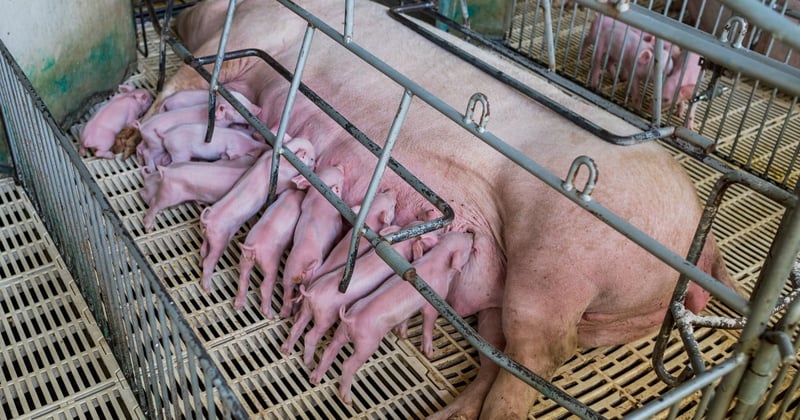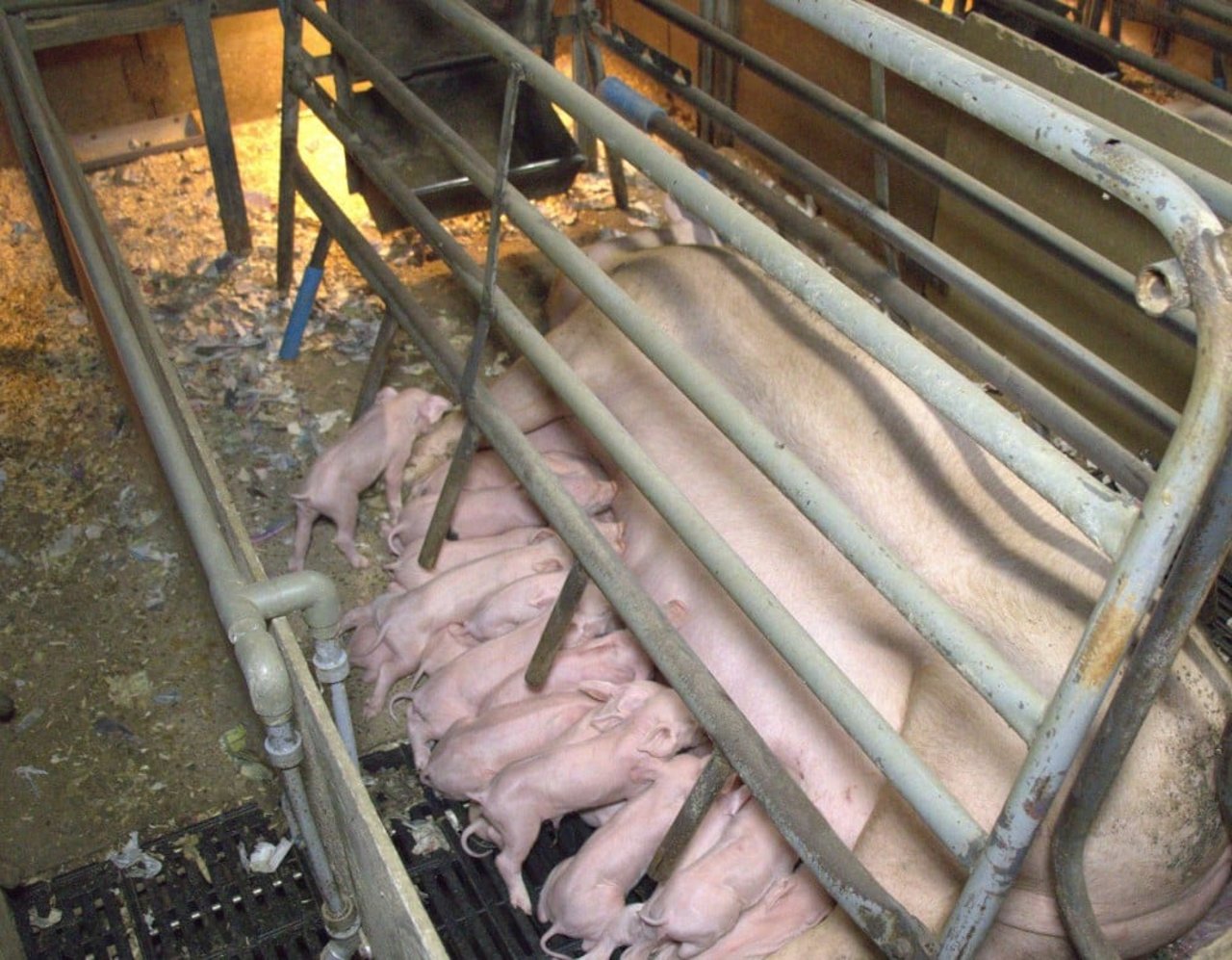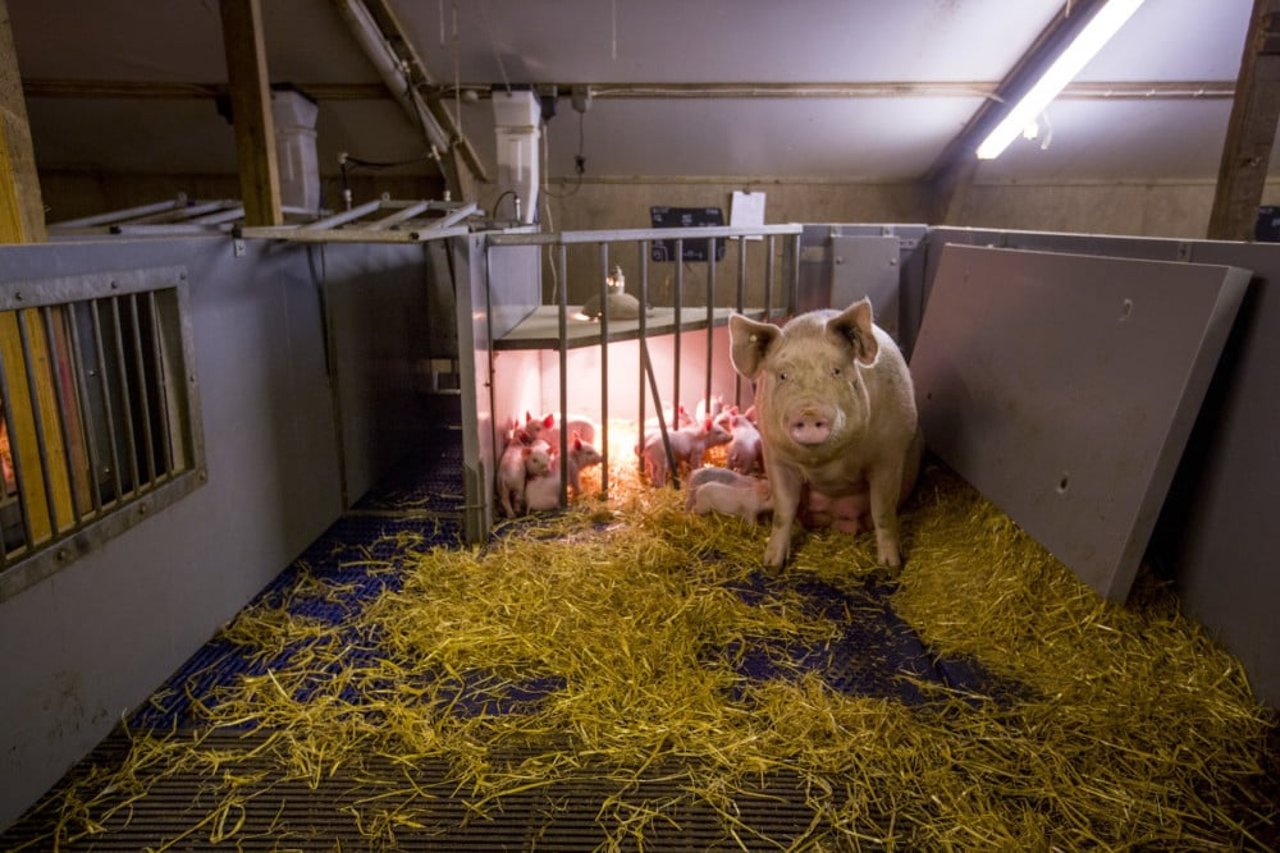
Learn about the practice which confines millions of mother pigs to a space not much larger than their bodies to deliver and suckle their piglets, and why we would like to see it banned.
What are farrowing crates?
Pig farrowing crates are metal cages that mother pigs are placed inside to give birth to their piglets. They are constructed of metal bars which restrict the movement of mother pigs. Each cage is around two metres long and less than one metre wide. The sow can only stand, lie down and take a few steps forward or back. Within the pen (crate) the piglets can reach their mother to suckle but she is unable to fully interact or socialise with them.
Image: An example of a farrowing crate from an undisclosed location in the UK.
What is the purpose of a farrowing crate?
The main purpose of the farrowing crate (cage) is to lower the risk of piglets being crushed by the mother by controlling her movements, particularly when lying down. With healthier, stronger mothers (especially from group housing not cages), this is not necessary and pens allowing mother pigs to turn around and effectively mother their young leads to more robust piglets.
When are mother pigs moved to farrowing crates and how long are they kept in them?
Most pregnant pigs are moved to farrowing cages from approximately 1 week before they are due to give birth until their piglets are weaned.
At what age are piglets weaned in the UK?
Piglets should be weaned at 28 days with regulations allowing weaning at 21 days under exceptional circumstances. However, an undercover investigation of pig farms in the UK carried out by World Animal Protection in 2018 found illegal early weaning on multiple farms with average days sometimes being below 21, indicating that this is a systemic problem. This is not only stressful for piglets and mothers but also causes digestive issues which arise from early weaning.
Why do we want to see farrowing cages banned?
Pigs are active animals that, given the right environment and left to their own devices, choose to root, forage and, in the case of sows, build nests to give birth in. Most crate systems prevent these natural behaviours. Their structures, with full or partially slatted floors, don’t accommodate nest building materials, or other devices that give sows comfort and relieve boredom.
Although pregnancy cages or sow stalls (these are cages that mother pigs spend the entirety of their pregnancy in) were banned in the UK in 1999, and around 40% of sows live outside, there are still improvements that could be made. We would like to see an end to the use of birthing cages or farrowing crates that mother pigs are placed inside to give birth to their piglets and where both mother pig and piglets remain until they are weaned. We would like to see the use of free farrowing systems where mother pigs give birth in pens filled with straw so they can build nests, move around, behave more naturally and raise their piglets.
Image: A mother pig and her piglets in a state of the art birthing pen at a higher welfare indoor pig farm in the UK
How can we make pigs lives better?
Together we have the power to end suffering, getting pigs out of cages into social groups, giving them materials like straw to manipulate, and stopping mutilations; so pigs can be pigs and live pain-free, move, play, root, explore, socialise and experience natural behaviour. Higher welfare, benefits pigs and people. Good animal welfare reduces stress, injury and disease in animals, decreasing the use of routine antibiotics, and providing high quality and better pork for you and your family. Around the world higher welfare, cage-free systems are improving productivity, while providing a life worth living for pigs.
Our Farming pigs and future proofing for a crate-free era report found these benefits of cage-free farming:
- Some farmers noticed that mother pigs experienced fewer leg problems and illness
- Some saw mother pigs showing improved natural mothering skills
- Mother pigs often produced more milk, making the piglets healthier, happier and grow faster
- As birthing is easier many also saw mother pigs with fewer post-birth infections, and less antibiotic use, which helps reduce the impact of pig farming on antimicrobial resistance
- Farmers also noticed mother pigs responding better to their human carers and turning around to approach them for a ‘nice’ scratch behind the ears
Join us and together we’ll protect animals from cruelty
Sign our No Future For Factory Farming petition and demand no more factory farms.

